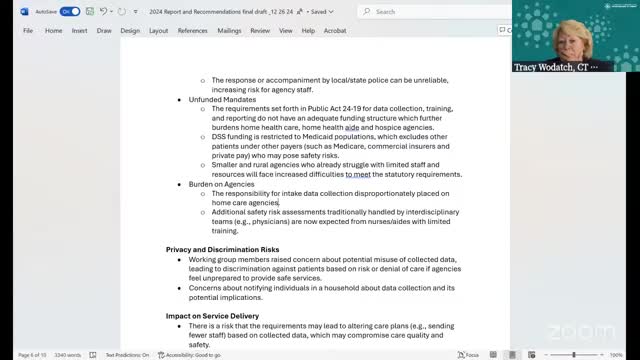Providers warn SB 1 mandates and current data tools place heavy burden on home‑health agencies; call for funding fixes and pilots
January 08, 2025 | 2025 Legislature CT, Connecticut
This article was created by AI summarizing key points discussed. AI makes mistakes, so for full details and context, please refer to the video of the full meeting. Please report any errors so we can fix them. Report an error »

Home‑health providers at the Workforce Safety Work Group warned that several statutory requirements tied to Public Act 24/19 (SB 1) — including mandated data collection, risk assessments and reporting — place a disproportionate burden on home‑care agencies, could delay starts of care, and raise privacy and discrimination risks.
Eric, speaking from a provider perspective, summarized a recurring theme: “The responsibility for intake data collection [is] disproportionately placed on home care agencies and does not compel transitioning facilities or health care providers referring to the service to share information.” Participants cited three practical problems with current evidence sources: the Judicial Branch website can be incomplete or hard to query, municipal crime reports are often outdated, and hospital electronic health records (Epic) are not universally accessible to home‑care agencies.
Providers described operational consequences. Barbara Pierce of Connecticut Hospice said the sector’s payer mix matters: “Connecticut Hospice is 87% Medicare,” and she warned that many proposed actions would not be reimbursed. Several providers noted that a Medicaid “subsequent visit” payment rule — which reduces payment for a second visit in the same day to roughly half the standard rate — discourages necessary follow‑up and “devalues” on‑site work. One speaker said a prior provider add‑on used to compensate for escorts and other safety measures was removed in 2016 and should be restored.
Members also flagged privacy and discrimination risks from broadly sharing risk information. Kim and others urged care in how data are used, noting risk is fluid and that an individual’s status can change quickly. Sarah, who said she works for the Department of Mental Health and Addiction Services, noted: “Risk is fluid. So you may have somebody 1 day that looks a certain way, but life factors change, and, that could significantly change their level of risk.”
The meeting ended with a plan to convene two technical subgroups: one to review risk‑assessment tools and another to examine data‑collection and disclosure requirements. Suggested participants include behavioral‑health providers, representatives from Demus (noted for existing tools), Department of Correction staff, hospital referral sources (e.g., CHA), and worker representatives. The group also discussed a pilot program idea to test integrated response models within agencies and to explore expanded safety initiative grant funding.
Why it matters: Participants said the state can either design workable, funded processes for data sharing and reassessments or impose mandates that increase barriers to access and increase legal/fiscal risk for providers. The group asked cochairs to convene the two technical subgroups within a week and to return recommendations to the full group for the next meeting.
Eric, speaking from a provider perspective, summarized a recurring theme: “The responsibility for intake data collection [is] disproportionately placed on home care agencies and does not compel transitioning facilities or health care providers referring to the service to share information.” Participants cited three practical problems with current evidence sources: the Judicial Branch website can be incomplete or hard to query, municipal crime reports are often outdated, and hospital electronic health records (Epic) are not universally accessible to home‑care agencies.
Providers described operational consequences. Barbara Pierce of Connecticut Hospice said the sector’s payer mix matters: “Connecticut Hospice is 87% Medicare,” and she warned that many proposed actions would not be reimbursed. Several providers noted that a Medicaid “subsequent visit” payment rule — which reduces payment for a second visit in the same day to roughly half the standard rate — discourages necessary follow‑up and “devalues” on‑site work. One speaker said a prior provider add‑on used to compensate for escorts and other safety measures was removed in 2016 and should be restored.
Members also flagged privacy and discrimination risks from broadly sharing risk information. Kim and others urged care in how data are used, noting risk is fluid and that an individual’s status can change quickly. Sarah, who said she works for the Department of Mental Health and Addiction Services, noted: “Risk is fluid. So you may have somebody 1 day that looks a certain way, but life factors change, and, that could significantly change their level of risk.”
The meeting ended with a plan to convene two technical subgroups: one to review risk‑assessment tools and another to examine data‑collection and disclosure requirements. Suggested participants include behavioral‑health providers, representatives from Demus (noted for existing tools), Department of Correction staff, hospital referral sources (e.g., CHA), and worker representatives. The group also discussed a pilot program idea to test integrated response models within agencies and to explore expanded safety initiative grant funding.
Why it matters: Participants said the state can either design workable, funded processes for data sharing and reassessments or impose mandates that increase barriers to access and increase legal/fiscal risk for providers. The group asked cochairs to convene the two technical subgroups within a week and to return recommendations to the full group for the next meeting.
View full meeting
This article is based on a recent meeting—watch the full video and explore the complete transcript for deeper insights into the discussion.
View full meeting
